
Beaumont is a lava-flooded crater located on the southwestern shore of the Mare Nectaris on Earth's Moon. It lies to the northwest of the similarly flooded crater remnant Fracastorius. To the west is the prominent crater Catharina. The crater is named after French geologist Léonce Élie de Beaumont.

Finsch is a relatively small lunar impact crater in the mid-part of Mare Serenitatis that has been almost completely covered by the mare, forming a ghost crater in the lava plain. It was named after German zoologist Otto Finsch. It is located to the south-southeast of the crater Sarabhai and northeast of Bessel.
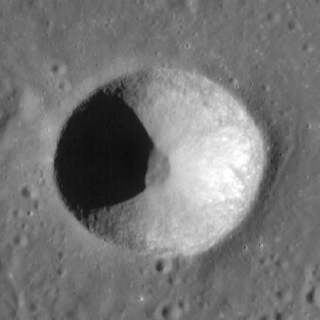
Biot is a small, bowl-shaped lunar impact crater located in the southern reaches of the Mare Fecunditatis. It is named after French astronomer Jean-Baptiste Biot."Biot (crater)". Gazetteer of Planetary Nomenclature. USGS Astrogeology Research Program. It is a circular formation with a sharp-edged rim that has not been significantly worn. The inner walls slope down to a relatively small interior floor. The albedo of the wide inner walls is higher than the surrounding lunar mare, giving it a light hue. To the southeast is the crater Wrottesley.
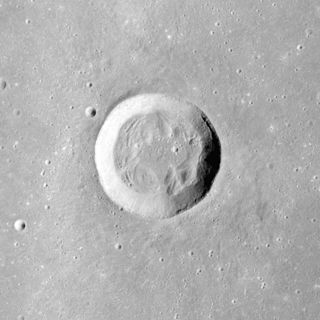
Bessel is a small lunar impact crater that is located in the southern half of the Mare Serenitatis. The crater was named after the German astronomer Friedrich Wilhelm Bessel in 1935. Despite its small size, this is the largest crater to lie entirely within the mare. It lies to the north-northeast of the crater Menelaus.

Doppelmayer is the remains of a lunar impact crater that lies on the southwest edge of Mare Humorum. It was named after the German mathematician and astronomer Johann Gabriel Doppelmayr. To the south-southeast is another flooded crater designated Lee, and to the southeast is Vitello. Just to the east-northeast of Doppelmayer lies the nearly submerged crater Puiseux.

Secchi is a small lunar impact crater formation on the northwest edge of Mare Fecunditatis. It was named after the 19th-century Italian astronomer Angelo Secchi. To the northeast is the crater Taruntius. The western rim is joined with a section of the minor Montes Secchi range. The rim of this crater has been opened in the northern and southern ends, leaving two curved ridges facing each other across the crater floor. To the south is a pair of rilles designated the Rimae Secchi. These lie near the edge of the mare, and have a combined length of about 40 kilometers.

Agatharchides is a lunar impact crater located at the southern edge of Oceanus Procellarum, in the region between the Mare Humorum and Mare Nubium. To the east-southeast is the crater Bullialdus, and to the south-southwest lies Loewy. It is named after the Greek geographer Agatharchides.

Belʹkovich is a large lunar impact crater of the form termed a walled plain. The formation has been heavily eroded by a history of subsequent impacts, leaving it reshaped, worn, and the features softened and rounded. Belʹkovich is located along the northeastern limb of the Moon, and so its visibility is subject to libration effects. From the Earth this crater is viewed from the side, making it difficult to view it in detail.

Bohr is a lunar impact crater that is located near the western lunar limb, in the area that is affected by librations. It is attached to the southwestern rim of the larger, eroded Vasco da Gama formation, and to the southeast of the crater Einstein. The crater was observed for the first time in 1963, by Arthus and Ewen Whitaker in the book Rectified Lunar Atlas.
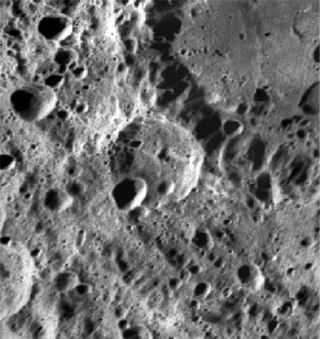
Belyaev is a lunar impact crater that is attached to the outer edge of the Mare Moscoviense, on the far side of the Moon. It is a worn formation with a small crater pair overlaying the southern rim, and several smaller craters across the relatively irregular interior.

Blackett is a lunar impact crater that lies on the far side of the Moon, behind the southwest limb. It lies beyond the southeast outer ring of the immense Mare Orientale basin. The formation of that major feature has left Blackett deeply marked with ridge features trending from the northwest. Much of the crater has been shaped by the ejecta from Mare Orientale, particularly along the western half of the crater.
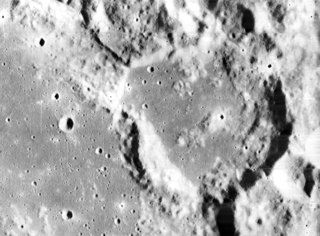
Condon is a lunar impact crater that lies on the eastern shore of the Sinus Successus, a bay along the northeast edge of Mare Fecunditatis. It was named after American physicist Edward U. Condon in 1976. It lies midway between the larger crater Apollonius to the north and the smaller Webb to the south on the Mare Fecunditatis. Condon was previously designated Webb R.

Cook is a lunar impact crater that lies in the western part of the Mare Fecunditatis, just to the southeast of the prominent crater Colombo. To the southwest is Monge.

Crozier is a lunar impact crater that is located on the southwest edge of Mare Fecunditatis, a lunar mare in the eastern part of the Moon's near side. It lies to the east-northeast of the prominent crater Colombo, and southeast of the small crater Bellot.

Daubrée is a lunar impact crater that is located to the southwest of the Mare Serenitatis, just to the west-southwest of the crater Menelaus in the Montes Haemus range. The small lunar mare Lacus Hiemalis lies along the southwest rim of Daubrée. The crater was named after French geologist Gabriel A. Daubrée. It was previously designated Menelaus S.
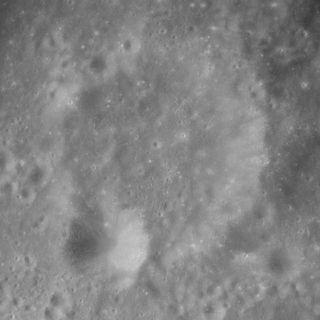
Dale is a small lunar impact crater located in the far eastern part of the Moon's near side, to the south of the Mare Smythii. It lies to the southeast of the larger crater Kastner and northeast of Ansgarius. The crater is located in a part of the lunar surface that is subject to libration, which can hide it from view for periods of time.

Eimmart is a lunar impact crater that is located near the east-northeastern limb of the Moon, to the northeast of the Mare Crisium. The northern and eastern outer rim of this crater borders on the narrow Mare Anguis. To the northwest of Eimmart are the smaller crater Delmotte and the prominent Cleomedes.

Fourier is a lunar impact crater that is located in the southwestern part of the Moon's near side, just to the southeast of the crater Vieta. To the northeast is the Mare Humorum. The rim of this crater is roughly circular, but appears oval when viewed from the Earth due to foreshortening.

Elvey is a lunar impact crater that is located on the far side of the Moon. It is located near the northern edge of the blanket of ejecta that surrounds the Mare Orientale impact basin. To the north of Elvey is the smaller crater Nobel.

Fridman is the remains of a lunar impact crater on the far side of the Moon. It lies due south of the huge walled plain Hertzsprung, and is attached to the northeastern rim of the crater Ioffe.





















